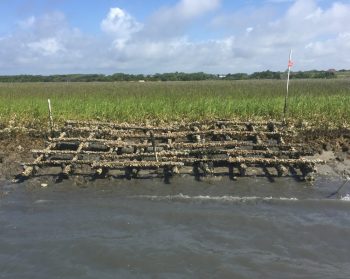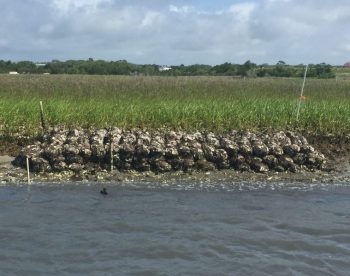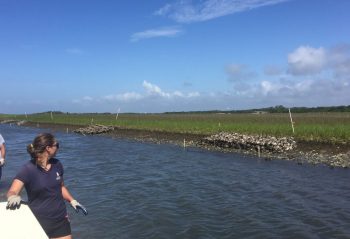Two of the main goals of the North Carolina Coastal Federation are to reduce the amount of marine debris on our coast and construct more living shorelines as an alternative to bulkheads and hard structures.
When building living shorelines, the federation uses plastic mesh bags filled with oyster shells to build oyster reefs that buffer waves that could otherwise increase erosion on the shoreline. While this method has been successful, the federation is looking for alternative methods that do not use plastic oyster bags which can contribute to marine debris.
One alternative method is called Oyster Catcher™, which was co-created by Dr. Niels Lindquist and Clammerhead of Sandbar Oyster Company. Oyster Catcher™ is a biodegradable material that promotes oyster growth by attracting oysters to the material that has been pre-seeded with spat, or juvenile oysters.
“With Oyster Catcher™, we construct open three-dimensional reef frameworks. As oysters settle and grow on the framework, they fill in the open space with their intertwined shells yielding a reef structure that can survive strong currents, waves and boat wakes,” said Dr. Lindquist of Sandbar Oyster Company.
“Pre-cut pieces of the cloths are soaked in a slurry of cement and then wet-formed to a wide variety of different shapes — flat panels, rods, disks and more — designed to accomplish different restoration tasks. The cloths are scaffold and cement the binder that holds the shape together. Being mostly of plant fibers, our products are biodegradable. They last long enough to get habitat creation started, be it oyster reefs or re-growing eroding salt marshes, then go away.”
In order to compare Oyster Catcher™ to the traditional mesh bag method used by the federation, Dr. Lindquist; Dr. Rachel Gittman, assistant professor of biology at East Carolina University; and Dr. Brandon Puckett, research coordinator with the North Carolina Coastal Reserve and National Estuarine Research Reserve, have begun conducting an experiment on Carrot Island. Carrot Island is located across from the town of Beaufort and is part of the Rachel Carson Reserve.
The team began placing 12-foot sections of reefs along two shorelines of Carrot Island on May 16. One shoreline was in a relatively low wave energy setting within a tidal creek fringed by salt marsh. The other shoreline was in a relatively high wave energy setting where the fringing salt marsh is exposed and eroding quite rapidly (about 1 meter per year). Within each shoreline, the team — including federation staff and volunteers — built four traditional oyster bag reefs and four other Oyster Catcher™ reefs. Sections of each shoreline were also left empty to serve as ‘controls.’
The most recent installment took place on June 4 and is currently being monitored by Drs. Gittman and Puckett as well as Dr. April Blakeslee, assistant professor of biology at East Carolina University, and Chris Moore and Emory Wellman, two of Dr. Gittman and Dr. Blakeslee’s graduate students.
“As the science supporting the efficacy of living shorelines mounts, it’s critical that we continue research to potentially improve upon traditional methods,” Dr. Puckett said. “One such avenue for doing so is to investigate the performance of alternative substrates such as Oyster Catcher™. For the Shoreline Restoration Experiment (SHORE) project, we have monitored the shoreline position and elevation, marsh vegetation coverage and oyster coverage before the reefs were built to provide a baseline. We will continue doing so for two years after the reefs were built. We hope that the project provides insight on the efficacy of an alternative living shoreline substrate, while serving to restore eroding salt marsh shoreline at the Rachel Carson Reserve.”
For more information about living shorelines visit nccoast.org/livingshorelines or the Living Shorelines Academy. The Living Shorelines Academy provides information that encourages the use of living shorelines as an erosion control practice.



